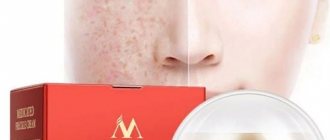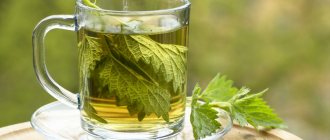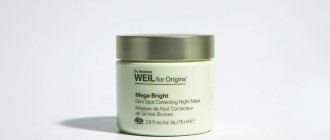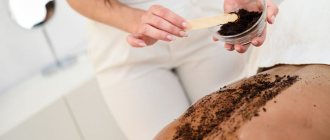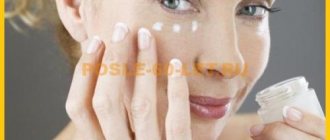Types of massage oils
All massage oils are divided into base, essential and mixtures. Mixtures can be ready-made or prepared independently at home.
Facial massage mixtures
Ready-made massage mixtures can be either natural or contain aromatic additives, dyes, active chemicals, etc. The composition must be indicated on the label. The label also indicates the skin type for which the mixture is intended. Some manufacturers provide a description of the action of the drug. The price of the finished mixture depends on the manufacturer and the components used. The advantage of such a product is its balanced composition and ease of use.
Disadvantages - unscrupulous manufacturers use low-quality ingredients to prepare massage mixtures, which can lead to allergic reactions, burns, and skin diseases.
Basic
To massage the skin of the face, neck and décolleté, base oil can be used in pure form or together with various additives.
Olive oil is the most basic oil in cosmetology. It is inexpensive and universal, contains a lot of vitamin E and A, nourishes and moisturizes the skin, increases its elasticity and starts tissue regeneration processes. Another oil that is used as a base oil is from grape seeds. It differs from olive oil in its lighter texture and contains polyunsaturated acids, vitamins and basic mineral compounds. Regular use allows you to speed up metabolic processes, cleanse cells of waste and toxins, and remove excess fluid.
Cosmetologists recommend using almond oil as a base product. It is suitable for skin care with pronounced age-related changes. Using the product during a massage allows you to improve and tighten your facial contours, get rid of wrinkles, and increase the tone of muscle tissue. Peach oil is recommended for aging skin, because... has a pronounced rejuvenating effect.
Sesame oil is used for sensitive or problematic skin. It cleanses well and soothes inflammatory processes, saturates with vitamins and nutrients. To cope with the first age-related changes, the mixture is made with jojoba oil.
Coconut oil is suitable for dry and dry skin. It not only softens, but also eliminates inflammation, nourishes and deeply moisturizes the skin. Coconut oil is also recommended as an anti-wrinkle remedy: it evens out the surface, improves skin tone and elasticity, softens and soothes.
Essential
Essential oils are used as additives to the base oil. For convenience, they are divided into several groups according to effect. The first group includes esters that normalize fat balance:
- Mandarin;
- Grapefruit;
- Orange;
- Lime;
- Kumquat;
- Lemon.
Anti-aging esters:
- Sandalwood;
- Jasmine;
- Myrrh;
- Geranium;
- Lavender;
- Rosewood.
Calming esters:
- Chamomile;
- Lavender;
- Bergamot;
- Eucalyptus;
- Rosemary.
Decongestants:
- Cinnamon;
- Oregano;
- Ginger;
- Carnation.
Esters of pine and thyme have a cleansing effect, cypress - lightens the skin, wheat germ - has a strong tightening effect.
About the beneficial properties of massage creams
Massage cream performs several functions at once. It ensures the correct displacement of the massage therapist’s hands during kneading, rubbing, stroking, and vibration. Easy gliding of the fingertips allows you to avoid excessive compression of the skin, the appearance of uncomfortable and even painful sensations.
The composition of any cream is represented by components, each of which has its own beneficial properties. They complement each other perfectly and mutually enhance their therapeutic effects. When combined, the ingredients of external massage products exhibit the following effects:
- relax skeletal muscles, eliminate muscle spasms;
- reduce the severity of pain;
- relieve chronic inflammatory processes;
- eliminate swelling;
- invigorate and tone;
- improve blood and lymph circulation;
- cleanse tissues of toxic substances and their breakdown products;
- replenish nutrient reserves.
The result of using creams during massage is skin tightening, increasing its firmness and elasticity. Their components gradually penetrate the tissues and gradually exhibit therapeutic effects. All external remedies not only have a positive effect on the course of diseases. They are not without cosmetic properties. Natural and synthetic components help retain moisture in the skin, saturate it with oxygen, and exfoliate dead epidermal cells.
Features of specialized oils
The cosmetic effect of base and essential oils is explained by their composition. The main component is acids. Oleic moisturizes and is well absorbed. Lauric acid helps prevent the development of fungi, bacteria and viruses in the pores. Myristic is responsible for the natural regeneration of cells, as well as the absorption of nutrients. Palmitic acid stimulates the production of collagen, hyaluronic acid and elastin, which leads to the elimination of wrinkles and an improvement in complexion. Another important component of the base for massage mixtures is caprylic acid. It improves skin breathing and restores acid-base balance. Linoleic acid penetrates into the deep subcutaneous layers and saturates them with nutrients.
In addition to active acids, essential oils are rich in terpene carbohydrates and alcohols. They have anti-inflammatory and antiviral effects, eliminate pain. Pure esters and phenols soothe and relieve muscle spasms. Aldehydes not only soothe, but also help cope with viruses, fungi, and bacteria.
Benefits of facial oils
Oil products have been used as cosmetics since ancient times. Even then their beneficial properties were known. Natural oils contain components that are related to human metabolism. Therefore, the body easily accepts and assimilates them. These components include:
- Vitamins;
- Phytosterols;
- Phospholipids;
- Various microelements.
Thanks to them, there is a beneficial effect on the skin of the face, namely:
- Active hydration of the dermal layer, which gives it firmness and elasticity;
- Toning, softening, nutrition of the epithelium;
- Acceleration of cellular metabolism;
- Improving blood circulation;
- Activation of the synthesis of fibrinogens and collagens;
- Restoration of the sebaceous glands;
- Anti-wrinkle;
- Fighting pigment spots;
- Providing an anti-inflammatory effect.
Interesting: What is hydrophilic oil needed for: how it works and rating of the best.
How to choose massage oil
When choosing a product, you should carefully read the composition, check the integrity of the packaging and expiration date. Fresh oil should not have a strong odor or be bitter; the best preservative is vitamin E. If a cosmetic product is used for the first time, it needs to be tested:
- Apply a small amount to the skin on the crook of the elbow, behind the ear or on the wrist;
- Assess absorbency and fat content;
- Assess for the presence of residual oily sheen;
- Check after 2-6 hours for any rashes or irritation.
A meat-based skin care product should not cause discomfort or burning. If the skin is inflamed after application, you should rinse it with warm running water and apply cream.
Rules of application
The use of oils in facial massage should take into account the following factors:
- You can massage only with a mixture at room temperature;
- You can do a massage only with warm skin;
- in massage it is necessary to use a gradual rubbing technique;
- It is advisable to control the absorption of the substance in order to use the optimal amount of the product.
Preliminary preparation
Before the session, it is important to clean the surface of the skin with a scrub or use the steaming method. The massage should be performed in a sitting position with a completely relaxed body, and there should be no abrasions or cuts on the skin. The presence of moles indicates that this area of the face will not be treated.
Execution technique
Oils are often used for facial massage in cosmetology.
The massage technique has a number of features:
- Massage movements are carried out strictly according to the scheme determined by a professional cosmetologist.
- Movements should be smooth and easy, without pressure or strong pressure.
- The cheekbone area, brow ridges, ear area, and folds near the mouth should be carefully worked out using directed movements along and across the wrinkles.
- The movements are performed in cyclic repetitions with light pats.
Blend recipes
For regular facial skin care, it is recommended to use the following recipe:
- macadamia oil – 1/3;
- hazelnut oil – 1/3;
- evening primrose oil – 1/3.
All ingredients are mixed and stored in one bottle in a cool place. If you need to make a relaxing composition, just add 3 drops of lavender essential oil, 1 tbsp of the mixture. Carrot or geranium oil is used to combat wrinkles.
Contraindications
If there is no redness or itching, facial massage oil can be used for a massage procedure. Contraindications include intolerance to the components in the composition, allergies and skin diseases. Before the massage procedure, it is recommended to conduct a standard test to find out the body's reaction to the use of a certain oil or combination of cosmetic products.
Is regular massage oil suitable for the face?
The skin of the face is sensitive and prone to allergic reactions, so for massage at home it is better to choose natural professional massage oils. You can also use baby oil on your face. This is a universal and hypoallergenic product with a rich composition of minerals and vitamins.
It is important that the purchased oil does not have a heating or cooling effect, and does not contain many chemical components or poisons of snakes, bees, spiders, etc.
Contraindications
The use of oils in cosmetology is limited by contraindications. These include not only individual intolerance to components. During pregnancy and breastfeeding, ethers can be used for massage only after consultation with a doctor. Lavender extract is not used for epilepsy and after a course of chemotherapy, as well as while taking iron-containing vitamins and medications. Eucalyptus ether cannot be combined with homeopathic medicines, and bergamot cannot be used for massage before sunbathing or going to the solarium.
Cosmetic oils containing extracts of juniper, mint, sage, cinnamon and ylang-ylang are not recommended for use by teenagers. Citrus essential oils can make your skin look youthful, but overusing them can cause burns.
Contraindications
Those with very oily skin will have to avoid massage using oil. The presence of profuse rashes, inflammation, or open wounds is a reason to postpone the procedure. In other cases, the use of base oil will not be an obstacle to massage.
If you intend to use a complex mixture with ethers, you will have to be more careful in assessing your own health. Contraindications to the procedure include:
- problems of the heart, blood vessels;
- high blood pressure;
- pregnancy;
- tendency to allergies.
Esters are used with caution. Before performing a facial massage, it is recommended to test for individual sensitivity to the components of the drug.
Massage using oils is an excellent procedure for maintaining a decent appearance and relaxation. The main thing is to choose the right method of exposure and use the appropriate oil mixture.
Preparing massage mixtures at home
Essential and basic oils for facial massage are designed to solve a complex of problems at once:
- Moisturize and saturate skin cells with vitamins;
- Strengthen blood vessels;
- Improve skin color and structure;
- Accelerate metabolism at the cellular level;
- Calm down or prevent the development of inflammatory processes;
- Normalize the functioning of the sebaceous glands;
- Improve blood circulation;
- Reduce the manifestation of age-related changes;
- Reduce pigmentation
Homemade facial oil can be prepared from base oil and essential oil. The finished product should be stored in the refrigerator in a glass jar with a lid. The shelf life depends on the components and reaches up to 7 months.
Natural recipes cover all skin types and possible problems, the main thing is to follow the dosage and compatibility.
Esters compatibility table
| Name | What goes with it? |
| Fir | Bergamot, cinnamon, juniper |
| Tea tree | Rosemary, lavender |
| Orange | Juniper, sage |
| Lemon | Ylang-ylang, bergamot, lavender, nerol |
| Mint | Pine, rosemary, rose, bergamot, patchouli, tea tree |
| Rose | Cloves, ylang-ylang, cinnamon, ginger, lavender, sage, frankincense |
| Pine | All citrus, sandalwood, juniper, lavender, rosemary |
| Cedar | Bergamot, cinnamon, lemon, ylang-ylang, sage, rose, patchouli, nerol, grapefruit |
| Nerol | Mint, lemon, sage, eucalyptus |
